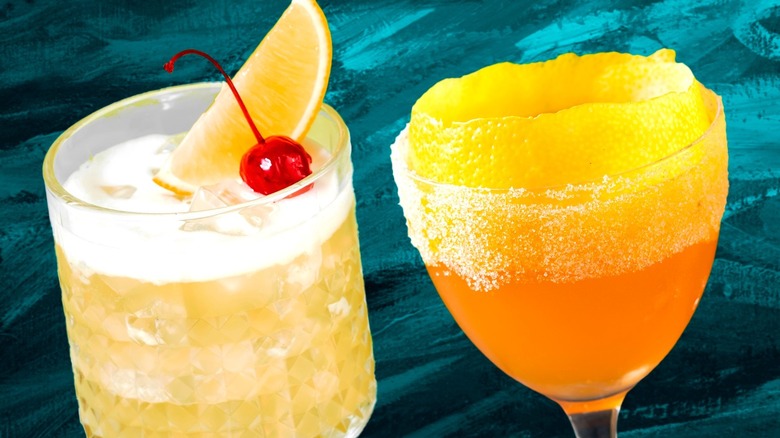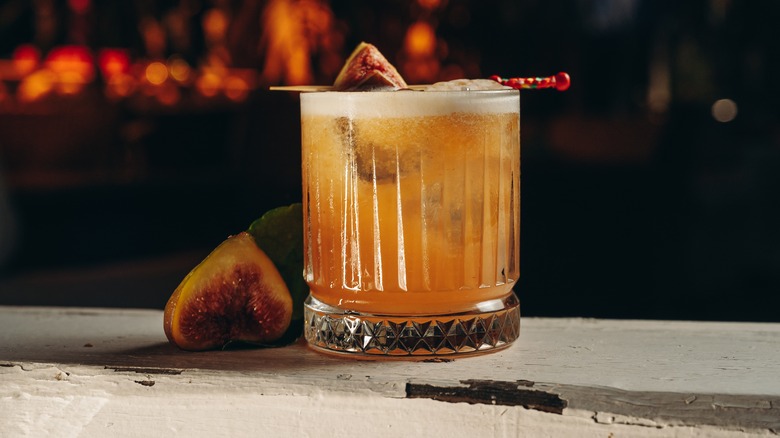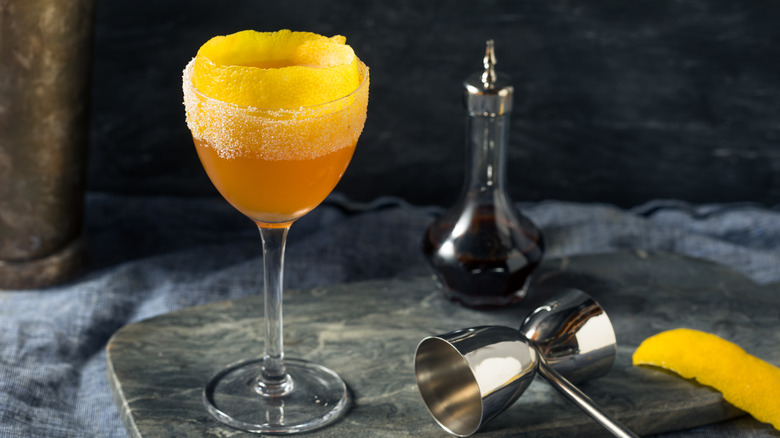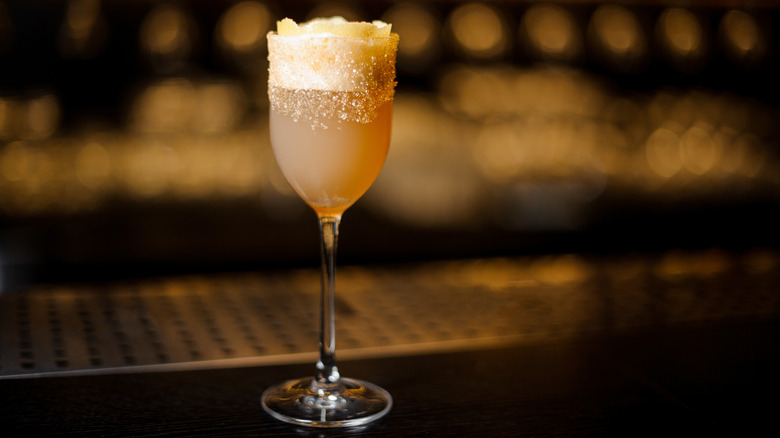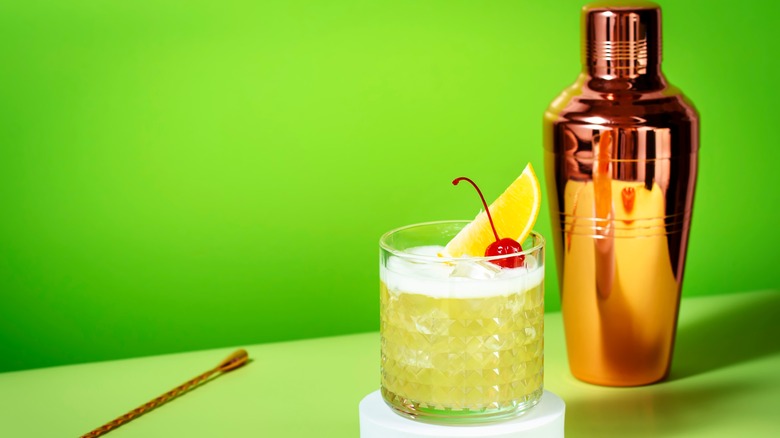Brandy Sour Vs Crusta: What's The Difference?
While often eclipsed by spirits like gin or whiskey, brandy can provide a delicious boozy base, too. Distilled since the Middle Ages — an early favorite of American colonists — the spirit appeared in some of the earliest drink creations. The milk punch is a brandy cocktail that dates back to the 1700s, with a recipe recorded by Benjamin Franklin.
By the time the 19th century rolled around, American mixology had entered its heyday, and brandy made frequent appearances. In the influential 1862 cocktail book, the "Bar-Tender's Guide," acclaimed cocktail curator Jerry Thomas noted a few slings with the spirit — including the brandy sour and brandy crusta.
The two popular drinks from the era share quite a few overlapping qualities. They rely on a bandy base paired with lemon, and simple syrup. However, the crusta also throws in orange and maraschino liqueur, which makes it more fruity and boozy. Alternatively, the brandy sour sticks to a classic sour template, which makes it the perfect jumping-off point for a range of creative renditions.
What is a brandy sour?
This brandy sling fits neatly into the sour template, combining liquor with citrus juice, a sweetener, bitters, and an optional — but delightfully creamy — egg white. The rendition with this grape-based spirit was one of the first sour recipes recorded in print, appearing in Jerry Thomas's 1862 compendium. The drink hasn't lost popularity since then, and its appeal is immediate. Especially when crafted with a top-ranked cognac, the cocktail perfectly balances tangy and boozy notes.
A slight riff on the cocktail is often considered the national drink of Cyprus. Said to have been created for King Farouk of Egypt during a visit to the island in the mid-20th century, this cocktail has caught on as an island favorite. This rendition — often pre-batched in larger volumes — mixes Cypriot-sourced brandy with lemonade in addition to fresh lemon juice. Some versions alternatively craft a lemon syrup to imbue a similar sweet essence. Oftentimes, this brandy sour is further topped with club soda, cementing its easy-drinking nature. Whether you opt for this rendition or the more spirituous classic, this pairing of brandy and citrus aligns well.
What is a brandy crusta?
The delicious brandy crusta is a 19th-century classic, with origins dating back to the 1850s. Invented by Italian bartender Joseph Santini in New Orleans, it's one of the city's first cocktail hits, only predated by the classic sazerac. Its build was innovative at the time, shaking an orange liqueur — typically drier triple sec but sometimes floral curaçao — alongside lemon juice, simple syrup, Angostura bitters, and the eponymous brandy. A few decades later, bartenders started imbuing another fruity layer through the use of maraschino liqueur, which became integrated into the recipe. Some cite this pairing of brandy and orange liqueur later influenced the creation of the classic sidecar cocktail.
The brandy crusta is also distinguished by the beautiful way it's served. The rim of a tall flute glass is first crusted with sugar, followed by an entire lemon zest peel that's wrapped around the interior of the drinking vessel. Then the cocktail is poured from the shaker into the glass, revealing its vibrant pink-orangish hue. Such an eye-catching form, combined with its complex fruity taste, has led to a brandy crusta resurgence after a near-disappearance in the 20th century.
The brandy crusta delivers fruiter, boozier flavors
Both cocktails pair brandy, lemon, and sugar, so it's no surprise their flavors are similar. If you're craving a fruity, brandy-based sling but don't have the liqueurs necessary for the crusta, the sour will scratch a similar itch. Nevertheless, the employed ratios and additional components do lend the brandy crusta a distinct drinking experience. Despite its many decades of popularity, it's a New Orleans cocktail that'll still give the sidecar a run for its money.
This cocktail tastes less tangy and citrus forward than the brandy sour, especially since its pour of lemon juice is diluted by other cocktail components. Plus, the orange and cherry liqueur boldly alter its palate, taking the relatively dry brandy sour into a more boozy realm. Their essence brings the fruit-forward complexity that defines the drink. The cocktail's sweeter nature is then further accentuated by a sugary rim — which is absent on the sour. As a result, the brandy crusta emerges as a stiff yet fun and fruity sling, as opposed to the brandy sour's more straightforward palate.
The brandy sour takes on more variations
The brandy crusta rests on the more obscure side of mixology, with a unique recipe that doesn't take on many riffs. Bartenders may swap out the specific brandy, the type of orange liqueur, or slightly tweak the employed ratios, but the cocktail remains relatively consistent.
Meanwhile, the brandy sour adheres to the foundational sour template, making it an easily modified cocktail recipe. In addition to the beloved Cypriot riff — which makes the sour more drinkable — there are many other flavor spins. A swap to an apple flavored type of brandy, like calvados or applejack, imparts an additional dimension to the cocktail. Or, a pour of apricot brandy complemented with bourbon serves up the Baltimore Bang.
The drink can also be tweaked with new fruit components and garnishes. The addition of orange and cranberry juice spins the cocktail into a more festive take, complete with a rose petal and orange slice garnish. Alternatively, the sour can be turned more zesty and refreshing with pomegranate juice, which will turn the drink a vivid red. And there's room for experimentation with bitters and simple syrup. Consider pairing brandy with a maple simple syrup or varying spiced bitters for a captivating rendition. Such modifications showcase how the brandy sour's straightforward build provides an exciting creative canvas.
